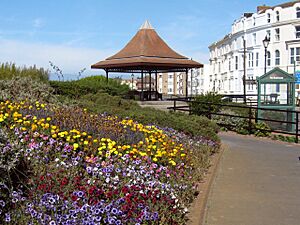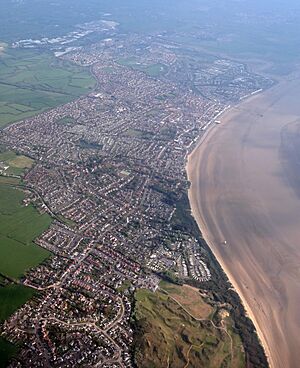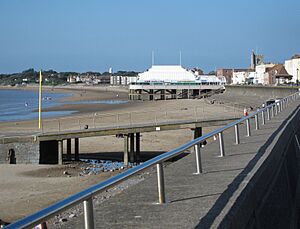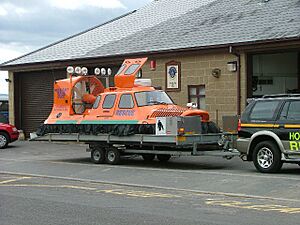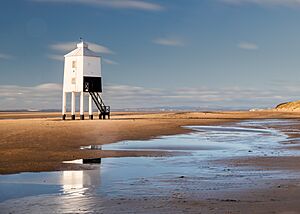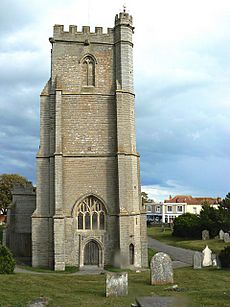Burnham-on-Sea facts for kids
Quick facts for kids Burnham-on-Sea |
|
|---|---|
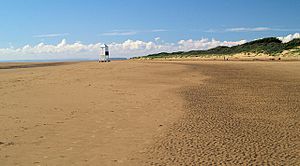 The beaches and low wooden pile lighthouse |
|
| Population | 19,576 (2011 census, including Highbridge) |
| OS grid reference | ST306492 |
| Civil parish |
|
| Unitary authority |
|
| Ceremonial county | |
| Region | |
| Country | England |
| Sovereign state | United Kingdom |
| Post town | BURNHAM-ON-SEA |
| Postcode district | TA8 |
| Dialling code | 01278 |
| Police | Avon and Somerset |
| Fire | Devon and Somerset |
| Ambulance | South Western |
| EU Parliament | South West England |
| UK Parliament |
|
Burnham-on-Sea is a fun seaside town in Somerset, England. It's located where the River Parrett meets the sea, in a place called Bridgwater Bay. For a long time, Burnham was just a small fishing village. But in the late 1700s, it started to grow. People discovered its lovely beaches and it became a popular seaside resort.
Burnham-on-Sea is part of a larger area called Burnham-on-Sea and Highbridge. It shares a local town council with the nearby town of Highbridge. In 2011, about 19,576 people lived in this whole area.
The town is well-known for its unique low lighthouse. This lighthouse was built in 1832. It's a special building with red and white stripes, and it's even listed as a historic site.
Burnham-on-Sea is on the edge of the Somerset Levels, which are low-lying lands. Because of its location, the town has a long history of building sea defences to protect itself from floods. This has been happening since Roman times! A big flood hit the area in 1607. Today, a strong curved concrete wall protects the town, finished in 1988. Many ships have been wrecked on the Gore Sands, which are sandbanks just offshore. This is why lighthouses are so important here.
Contents
History of Burnham-on-Sea
The name Burnham comes from old English words. Burna means "stream" and Hamm means "enclosure". "On-Sea" was added later to show it's a coastal town, as there are other places named Burnham.
The story of Burnham-on-Sea is closely linked to how people have reclaimed land from the sea. The Romans were probably the first to settle here. They built systems to drain the Somerset Levels and help ships sail into the River Parrett. When the Romans left, these drainage systems weren't kept up. The land became a tidal salt marsh again.
It's thought that small villages existed here around the time of the Norman Domesday Book. The church and its lands in Burnham were given to Gloucester Abbey a long time ago. Later, they became part of Wells Cathedral.
One of the biggest events in the town's history was the Great Flood of 1607. Since then, many sea defences have been built. In 1911, a concrete wall was added. After World War II, parts of a special floating harbour (called a Mulberry harbour) used in the Normandy Landings were buried in the sand to help protect the coast. Today, a large curved concrete wall, finished in 1988, defends the town from floods. This wall is also a cool place for graffiti and street art.
During World War II, a US Navy ship called USS Aulick was given to the British. It was renamed HMS Burnham (H82). In 1942, the town of Burnham-on-Sea officially "adopted" the ship. Sailors from the ship even visited the town in 1944.
Geography of Burnham-on-Sea
Burnham-on-Sea is known for its wide beaches and mudflats. These mudflats can be dangerous for people and boats. The town is near the mouth of the River Parrett, which flows into the Bristol Channel. The Bristol Channel has the second highest tidal range in the world, meaning the difference between high and low tide is huge. It can be as much as 11 metres (36 feet)!
Burnham's mudflats are a key feature of Bridgwater Bay. At low tide, the sea can go out for over 1.5 kilometres (1 mile). Bridgwater Bay is a special area with mudflats, saltmarshes, and sandflats. It's protected as a Site of Special Scientific Interest and is important for wildlife.
Apex Leisure and Wildlife Park is a large park in Burnham-on-Sea. It was made from old clay pits that filled with water. Now, the lakes are home to lots of wildlife and are used for fun activities.
About 5 kilometres (3 miles) west of Burnham-on-Sea is Hinkley Point. This area is known for its large nuclear power stations.
Weather in Burnham-on-Sea
Burnham-on-Sea has a mild climate, which means it's generally not too hot or too cold. It's often wetter than other parts of the UK. The average temperature is about 10°C (50°F). Summers are warm, with temperatures around 21°C (70°F) in July and August. Winters are cool, with temperatures often around 1°C or 2°C (34°F or 36°F). The town gets about 700 mm (28 inches) of rain each year.
Sea Defences in Burnham-on-Sea
Because of the big flood in 1607, Burnham-on-Sea has a long history of building defences against the sea. In 1911, a concrete sea wall was built. After World War II, more defences were added using parts of a Mulberry harbour.
In 1981, a huge storm hit the coast. It caused a big rise in sea level and flooded many homes and businesses. The damage was very expensive. Because of this, a new, stronger sea wall was built. This project cost £7 million and took five years to finish, opening in 1988. The new wall is 1.6 kilometres (1 mile) long and 3.2 metres (10 feet) high. It also created a wider promenade for people to walk on.
Lifeboats and Rescue Services
Many ships have been wrecked on the Gore Sands near Burnham-on-Sea. The town has had a lifeboat service since 1836. Today, the Burnham-on-Sea Lifeboat Station is home to the Royal National Lifeboat Institution (RNLI). They use two fast boats to rescue people.
The Burnham-on-Sea Area Rescue Boat (BARB Search & Rescue) was started in 1992. They help rescue people in the Bridgwater Bay area. Their boathouse was built in 1994 by a TV show. In 2002, a young girl sadly died on the mudflats. This led to a campaign to get a special rescue hovercraft. BARB now uses two hovercraft, named Spirit of Lelaina and Light of Elizabeth.
How Burnham-on-Sea is Governed
The local area of Burnham-on-Sea and Highbridge has a civil parish council. This council helps with local issues like managing money for the town and checking building plans. They also work with the police and local groups to keep the area safe. The council helps maintain roads, footpaths, and public transport.
Burnham used to be a much larger area. Over time, it was divided into smaller parts. Since April 2023, all local council services in Somerset are handled by one big council called Somerset Council.
Burnham-on-Sea also has two local voting areas, called 'wards' (Central and North). These areas have a total population of about 13,601 people. The town is part of the Bridgwater area, which elects one Member of Parliament (MP) to the UK Parliament.
Famous Landmarks
Lighthouses of Burnham-on-Sea
Because of the dangerous shifting sands in the Bristol Channel, several lighthouses have been built in Burnham-on-Sea to guide ships.
The first lighthouse, called the Round Tower, was built near the church. It was used until 1832.
The tall, 110-foot (34-metre) High Lighthouse was built in 1830. It used a paraffin lamp and was made automatic in 1920. In 1992, it was sold and later bought by Patrick O'Hagan. It's now a holiday home! It's a Grade II listed building.
The low wooden pile lighthouse, also known as the "Lighthouse on legs" or "Nine Pins", was built two years later. It's 36 feet (11 metres) high and stands on nine wooden legs. It's painted white with a red stripe. Its lights were turned off for a while but were switched back on in 1993 when the High Lighthouse lights were turned off for good.
Burnham-on-Sea Pier
A stone pier was built in 1858 for a railway. A boat service to Wales started in 1860, but it didn't last long. The pier still has its old railway lines hidden under concrete.
The concrete pier, built between 1911 and 1914, is said to be the shortest pier in Britain. Some people call it more of a beach pavilion. In 2008, it was named one of the top five piers in Britain by a newspaper.
The Royal Clarence Hotel
This hotel was built in 1796. It was home to the very first bar in Burnham-on-Sea.
Historic Buildings
Along the Esplanade, which is the walkway by the sea, you can find several historic buildings from the early 1800s. These include numbers 44, 46, and 47. On Berrow Road, there's also an old drinking fountain from 1897.
Education in Burnham-on-Sea
For younger children up to age 11, there are several primary schools in Burnham-on-Sea. These include Berrow Church of England Primary School, Burnham-on-Sea Community Infants School, St Andrew's Church of England Junior School, and St Joseph's Catholic Primary School.
The main secondary school for older students is The King Alfred School. It's a large school located in Highbridge. It's a special school for sports. The King Alfred Sports Centre next to the school is used by both the school and the town.
Places of Worship
The main church in town is St. Andrew's. It's a very old building, dating back to the 1300s. Its 78-foot (24-metre) tall tower leans a bit because of its old foundations. In the 1700s, a light was placed on the tower to help guide fishing boats.
Burnham-on-Sea also has places of worship for different faiths, including Baptists, Methodists, Roman Catholics, and Jehovah's Witnesses.
Transport in Burnham-on-Sea
Burnham-on-Sea used to have its own train station, which opened in 1858. You could even catch a ferry to South Wales from the jetty there. The station closed for passengers in 1951 and for goods in 1963.
The nearest train station now is Highbridge and Burnham. It opened in 1841.
The town is about 3 miles (5 kilometres) from the M5 motorway and the A38 road, making it easy to reach by car. There are also two main bus routes that serve Burnham-on-Sea, connecting it to Taunton and Weston-super-Mare.
Culture and Sport
Burnham-on-Sea is part of the exciting West Country Carnival circuit, which features amazing illuminated floats.
The Burnham and Berrow Golf Course is a large, 36-hole championship course at the north end of town.
Burnham-on-Sea is a great place for kitesurfing and other water sports. It even has its own sailing club.
For land-based activities, there's bowls, a swimming pool, and a sports academy.
The Burnham-on-Sea rugby union club started in 1887. They play in a regional league. The Burnham-on-Sea cricket club was formed in 1861. A famous player named Sammy Woods played for them and also for England and Australia!
In 2016, the town hosted the Burnham Spray Jam, which brought amazing street art to the streets. This event is now part of BOSfest, which also includes music, poetry, and street entertainment.
The town is also home to the award-winning eat:Festivals. These festivals celebrate local food and drink. They are free to attend and feature workshops, cooking demonstrations, and over 100 local producers.
Famous People from Burnham-on-Sea
Many interesting people have connections to Burnham-on-Sea. Thomas Alan Stephenson, a marine biologist, was born here in 1898. So was John Pople, a famous chemist, in 1925. The novelist Isobel English went to school here. Arthur Gilbert, who was confirmed as the world's oldest triathlete in 2011, lives in the town. George Shelley from the boy band Union J also lived here and went to The King Alfred School, Highbridge. World champion darts player Gary Anderson also lives in Burnham-on-Sea.
Twin Towns
Burnham-on-Sea is twinned with:
- Cassis, France
See also
 In Spanish: Burnham-on-Sea para niños
In Spanish: Burnham-on-Sea para niños



